Compared to other animals, the human hearing range is limited. Not only can we not hear all the full range of sounds around us, but as we grow older, our hearing weakens.
If you worry you may be losing hearing in one or both ears, or you’re simply interested in finding out what a human’s hearing range encompasses, this article is for you.
Key Takeaways
- Your ability to hear a range of audio frequencies can significantly impact your health and quality of life.
- A sound’s volume is measured in decibels (dB), while its pitch is measured in hertz (Hz).
- Most healthy adults have an average hearing range of between 20 and 20,000 hertz.
- Sounds below 20 Hz are called infrasound, and those above 20,000 Hz are called ultrasound.
- You can counter hearing loss by wearing hearing aids in one or both ears.
What Is the Human Hearing Range?
The human hearing range typically changes over time and is most frequently measured in kilohertz (kHz).
The average human can detect sound in the 20Hz to 20 kHZ [1]. As we age, we all experience hearing loss in varying degrees. By the time we reach adulthood, most people can only hear sounds up to 15–17 kHZ.
A sound’s frequency is measured by the number of vibrations it creates per second.
Between 20 and 200 hertz is known as low-frequency sound, and anything below is known as infrasound [2]. As the frequency of sound decreases, so does our ability to detect and distinguish it.
Sounds over 20 kHz are often too high for humans to hear and are typically referred to as ultrasound.
Sounds can be measured and described in a variety of ways, including:
Loudness vs. Pitch
Loudness and pitch are not the same thing.
How loud a sound is refers to the amplitude of the sound waves created by it; the bigger the amplitude, the louder the sound.
On the other hand, a sound’s pitch refers to the frequency of the sound waves’ vibrations.
Loudness is measured in decibels (dB), while pitch is typically measured in hertz (Hz).
Both are vital to our ability to hear and differentiate between sounds, and both are involved in the deterioration leading to hearing loss [3].
Decibels vs. Hertz
Both decibels and hertz are vital to assessing a person’s hearing range and possible hearing loss [4].
A decibel is a measure of the loudness of a sound, and hertz is used to measure the frequency of a sound.
As an example, a person screaming at the top of their lungs creates a sound equal to between 30 and 150 Hz and around 90 dB.
Normal Hearing Range by Age
Hearing loss as we get older is a natural process and involves a decrease in the frequency and loudness of sound we can hear. The condition affects about 10% of adults [5].
Who do you think is more likely to experience trouble hearing?
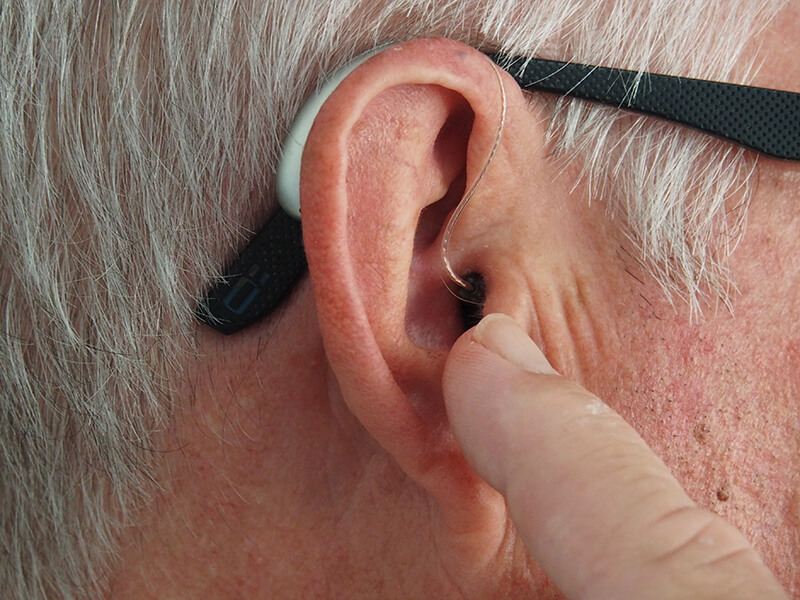
Most often, the upper limit of our hearing frequency is what is most affected.
A good measure of a person’s hearing range relative to their age can be estimated as below:
- 8,000 Hz: Anyone without a hearing impairment
- 12,000 Hz: People under 50
- 15,000 Hz: People under 40
- 16,000 Hz: People under 30
- 17,000 Hz: People under 24
Most children and babies can hear sounds up to and above 20 kHz.
The detection of these sounds depends on a rising threshold of its loudness or how high the sounds were in decibels.
Hearing Range by Age Chart
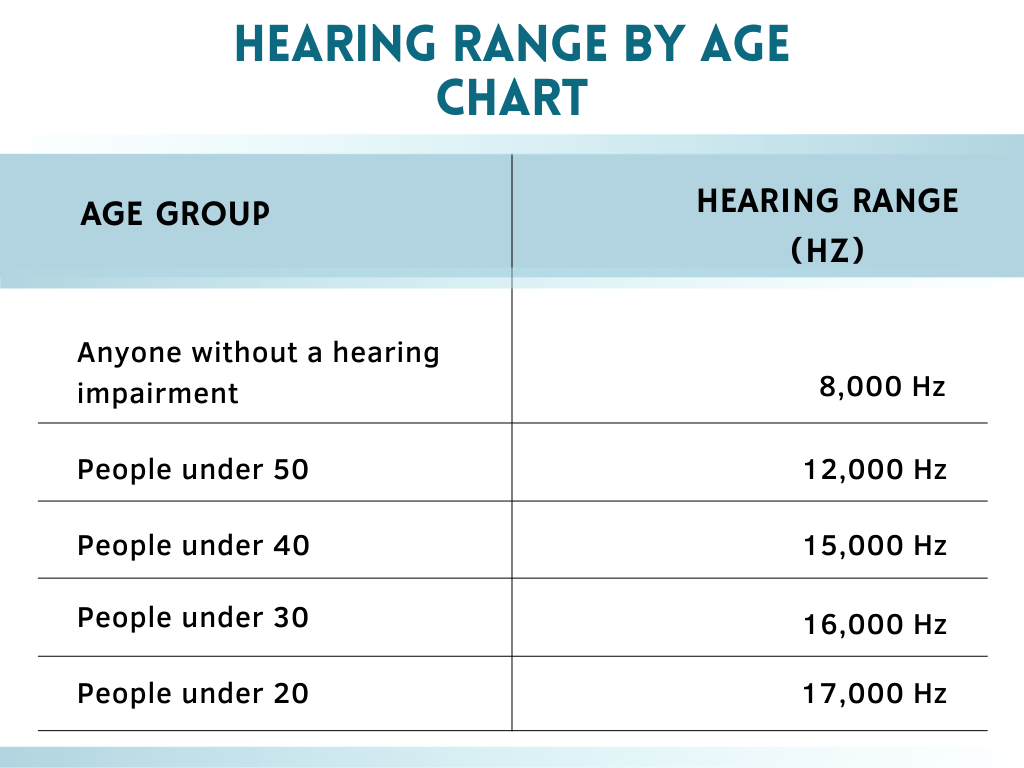
Hearing Age Test
Hearing tests can help you determine whether or not you are experiencing atypical hearing loss. Some of the best sites for a free hearing test are listed in this article.
Young people are usually able to hear higher frequency sounds better than older individuals. If you’re worried, you may be tone-deaf. Taking a tone-deaf test could help you determine your pitch sensitivity.
An online hearing test typically requires you to play and listen to an audio of words, numbers, or phrases with varying amounts of background noise. These types of hearing tests make assessing your hearing abilities accessible to far more people than the tests conducted by doctors or healthcare providers [6].
You will either be asked to choose a picture or line of text corresponding to the sound.
These tests are great for measuring your overall hearing range but may not be effective if you have single-sided deafness or severe hearing loss in only one ear [7]. If you suspect you may be losing your hearing abilities in one ear, you will have to visit a doctor for comprehensive testing.
FAQ
Below are the answers to some of the most frequently asked questions regarding the human hearing range.
What Is the Normal Hearing Range in DB?
In humans, the normal hearing range in decibels differs according to the sound frequency [8].
Typically, a person’s decibel hearing range is between 0 dB and 120 dB, although sounds above 103 dB could cause damage to your ears and result in hearing loss [9].
What Is the Normal Hearing Range for 30-Year-Olds?
Most people around 30 years old have a hearing range of between 20 Hz and 20 kHz.
If you are worried you may be experiencing unusual hearing loss, taking an online hearing test could help you measure the frequencies at which you can detect sounds and speech and help ease your fears or encourage you to seek treatment.
Can You Hear 15,000 Hz?
As we age, we naturally begin to suffer from gradual hearing loss. This could cause our range of hearing to narrow. Healthy adults under 40 should hear sound up to 15 kHz in frequency.
Unusual high-frequency hearing loss, also called presbycusis, may also occur and require hearing aids to rectify.
Is 15,000 Hz Good Hearing?
The ability to hear sounds at frequencies up to 15 kHz is typical and expected in all healthy adults under 40.
Trouble hearing sound above this frequency could be due to a hearing loss condition called presbycusis, which may require hearing aids to counter.
What Is the Highest Audible Frequency?
Most young people can hear high-pitched sounds up to 20 kHz in frequency.
Although people can comfortably listen to sounds at these frequencies, some can detect sound and audio up to 28 kHz, but not higher [10].
Can Humans Hear 50,000 HZ?
Humans’ ability to hear high-frequency sounds is limited.
Some of us can hear sounds up to 28,000 Hz in frequency, but 50,000 Hz is impossible.
Sounds at this frequency could cause damage to our ears at the wrong decibel threshold, or we simply won’t be able to hear a thing.
What Impacts the Range of Frequencies We Can Hear?
A range of factors can affect our hearing health, including [11]:
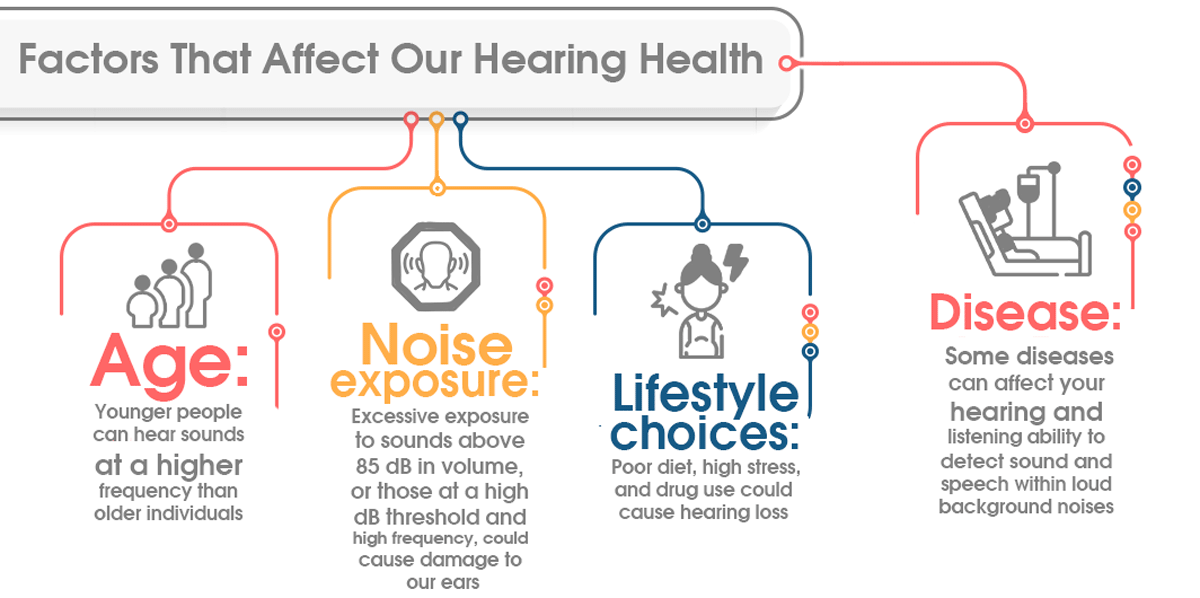
- Age: Younger people can hear sounds at a higher frequency than older individuals.
- Noise exposure: Excessive exposure to sounds above 85 dB in volume, or those at a high dB threshold and high frequency, could cause damage to our ears.
- Lifestyle choices: Poor diet, high stress, and drug use could cause hearing loss.
- Disease: Some diseases can affect your hearing and listening ability to detect sound and speech within loud background noises.
Conclusion
Suffering from any sort of hearing loss can be a stressful experience.
Thankfully, people suffering from severe types of hearing loss on one ear or both ears can use hearing aids to increase their ability to detect sound and speech regardless of background noise.
If you’re interested in finding the right hearing device for you, take a look at our MDHearingAid reviews, which provide a comprehensive guide to some of the best listening aids on the market.
References:
- Purves, Dale. “The Audible Spectrum.” Neuroscience. 2nd Edition., U.S. National Library of Medicine, 1 Jan. 1970, www.ncbi.nlm.nih.gov/books/NBK10924/.
- CS;, Møller H;Pedersen. “Hearing at Low and Infrasonic Frequencies.” Noise & Health, U.S. National Library of Medicine, pubmed.ncbi.nlm.nih.gov/15273023/.
- ME;, Schenkman BN;Nilsson. “Human Echolocation: Pitch versus Loudness Information.” Perception, U.S. National Library of Medicine, pubmed.ncbi.nlm.nih.gov/22128556/.
- G;, Beynon. “When Is a Decibel Not a Decibel?: The Application of Decibel Scales and Calibration in Clinical Audiology.” The Journal of Laryngology and Otology, U.S. National Library of Medicine, pubmed.ncbi.nlm.nih.gov/8288991/.
- B;, Isaacson. “Hearing Loss.” The Medical Clinics of North America, U.S. National Library of Medicine, pubmed.ncbi.nlm.nih.gov/20736107/.
- De Sousa KC;Swanepoel W;Moore DR;Smits C; “A Smartphone National Hearing Test: Performance and Characteristics of Users.” American Journal of Audiology, U.S. National Library of Medicine, pubmed.ncbi.nlm.nih.gov/30452748/.
- Usami SI;Kitoh R;Moteki H;Nishio SY;Kitano T;Kobayashi M;Shinagawa J;Yokota Y;Sugiyama K;Watanabe K; “Etiology of Single-Sided Deafness and Asymmetrical Hearing Loss.” Acta Oto-Laryngologica, U.S. National Library of Medicine, pubmed.ncbi.nlm.nih.gov/28366032/.
- Holmes, Emma, and Timothy D Griffiths. “’Normal’ Hearing Thresholds and Fundamental Auditory Grouping Processes Predict Difficulties with Speech-in-Noise Perception.” Scientific Reports, Nature Publishing Group UK, 14 Nov. 2019, www.ncbi.nlm.nih.gov/pmc/articles/PMC6856372/.
- C;, Meyer-Bisch. “[Measuring Noise].” Medecine Sciences : M/S, U.S. National Library of Medicine, pubmed.ncbi.nlm.nih.gov/15885208/.
- K;, Ashihara. “Hearing Thresholds for Pure Tones above 16 KHz.” The Journal of the Acoustical Society of America, U.S. National Library of Medicine, pubmed.ncbi.nlm.nih.gov/17927307/.
- Mills, J H, and J A Going. “Review of Environmental Factors Affecting Hearing.” Environmental Health Perspectives, U.S. National Library of Medicine, Apr. 1982, www.ncbi.nlm.nih.gov/pmc/articles/PMC1568958/.
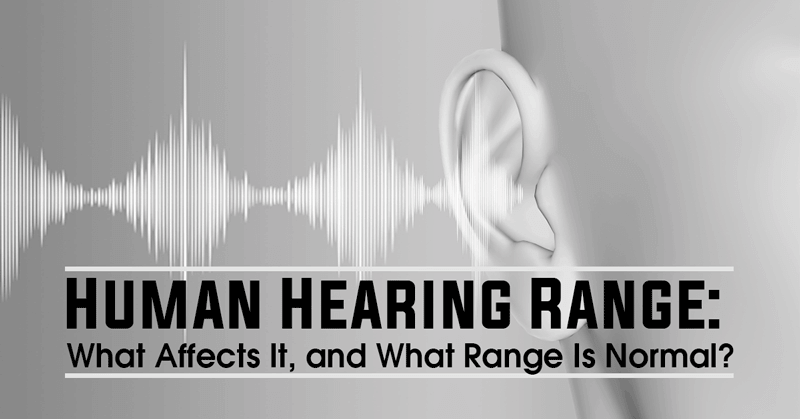
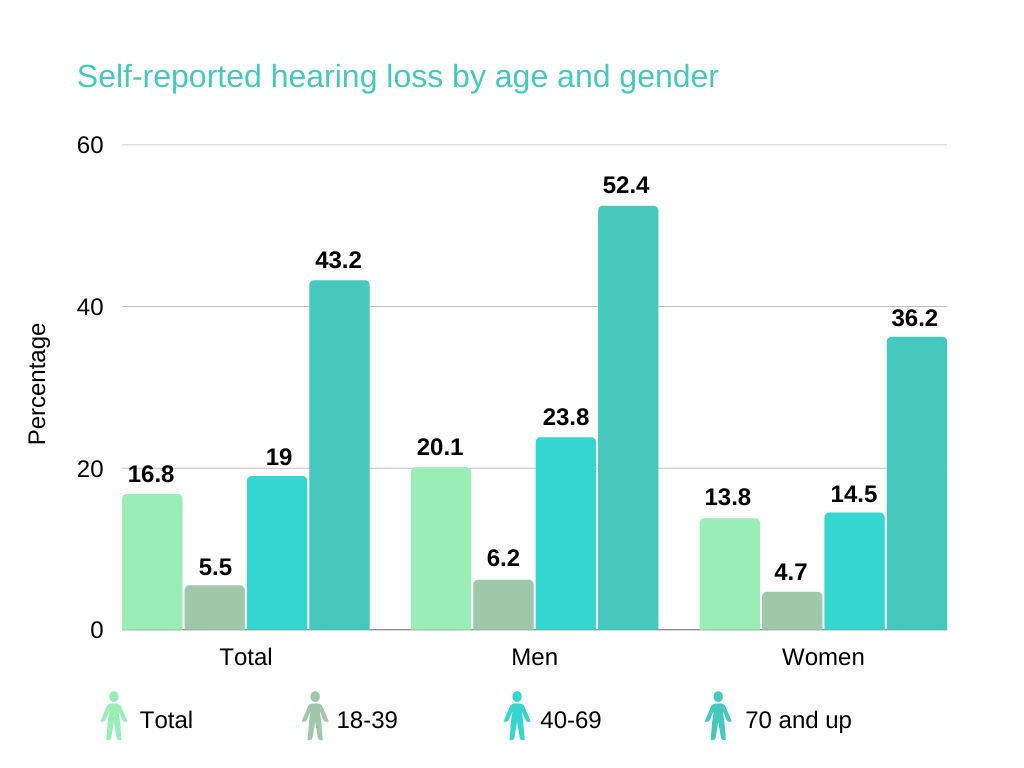




Leave a Reply